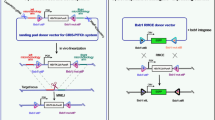Abstract
The AttSite® Recombinase Technology from Intrexon, Blacksburg, VA, utilizes specific DNA sequences and proprietary recombinase enzymes to catalyze the insertion of a gene of interest at a specific location in the host cell genome. Using this technology, we have developed Chinese Hamster Ovary (CHO) cell lines that have incorporated attB recombination sites at highly transcriptionally active loci or ‘hot spots’ within the cell genome. Subsequently, these attB site containing host cell lines could then be used for the expression of future Centocor products. Candidate production cell lines would be generated by a simple recombination event. Since the therapeutic gene of interest would preferentially integrate into the pre-selected high-expressing attB site, candidate cell lines would consistently express high levels of the gene of interest. We have been able to demonstrate that the AttSite® Recombinase Technology could be a valid approach for the development of high-expressing production cell lines.



Similar content being viewed by others
References
Labrador, M., & Corces, V. G. (2002). Setting the boundaries of chromatin domains and nuclear organization. Cell, 111(2), 151–154.
Branda, C. S., & Dymecki, S. M. (2004). Talking about a revolution: The impact of site-specific recombinases on genetic analyses in mice. Developmental Cell, 6(1), 7–28.
Groth, A. C., & Carlos, M. P. (2004). Phage integrases: Biology and applications. Journal of Molecular Biology, 335, 667–678.
Smith, M. C., & Thorpe, H. M. (2002). Diversity in the serine recombinases. Molecular Microbiology, 44(2), 299–307.
Russell, J. P., Chang, D. W., Tretiakova, A., & Padidam, M. (2006). Phage Bxb1 integrase mediates highly efficient site-specific recombination in mammalian cells. BioTechniques, 40, 460–464.
Patent: Site-specific serine recombinases and methods of their use. U.S. Provisional Patent Application 20080020465. Filed 08/20/2007. Inventors: Padidam, M.
Author information
Authors and Affiliations
Corresponding author
Additional information
Molecular Biotechnology—9th Peace Conference Proceedings
Rights and permissions
About this article
Cite this article
Campbell, M., Corisdeo, S., McGee, C. et al. Utilization of Site-Specific Recombination for Generating Therapeutic Protein Producing Cell Lines. Mol Biotechnol 45, 199–202 (2010). https://doi.org/10.1007/s12033-010-9266-5
Published:
Issue Date:
DOI: https://doi.org/10.1007/s12033-010-9266-5




